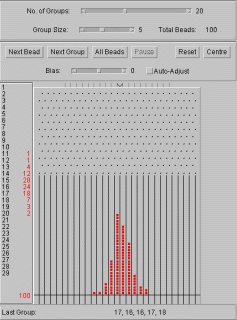
(Click the image to open the beadboard)
The empirical rule can be demonstrated using a simple simulation, known as a beadboard. The beadboard is basically a model of a normally-distributed, stable and predictable process, and is often used to demonstrate the concept of variation.
The board has a hopper at the top, from which beads are released, they then pass through a pin-board before being collected in numbered columns at the bottom. Although all of the beads are released from the same point, their path through the pin-board is random, as each time a bead strikes a pin, it may bounce either to the left or right of the pin. Thus, instead of all accumulating in the same column, the beads are distributed across a number of columns.
For this demonstration, we will be using a simple applet (a program which runs in your web-browser) which is a computerised version of a beadboard (shown in the image below). You can run the program by clicking on the link in the toolbar. To find out more about how the program works, you can read the help file by clicking on the toolbar link labelled 'help'.